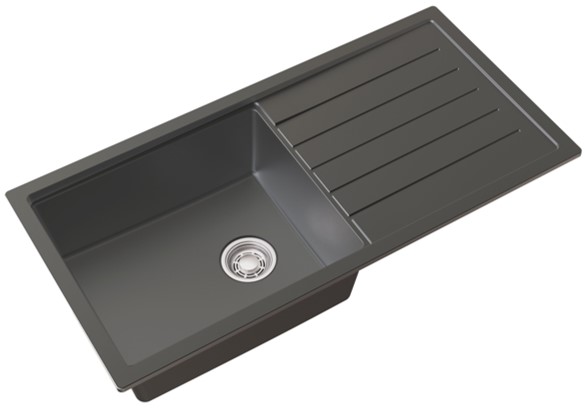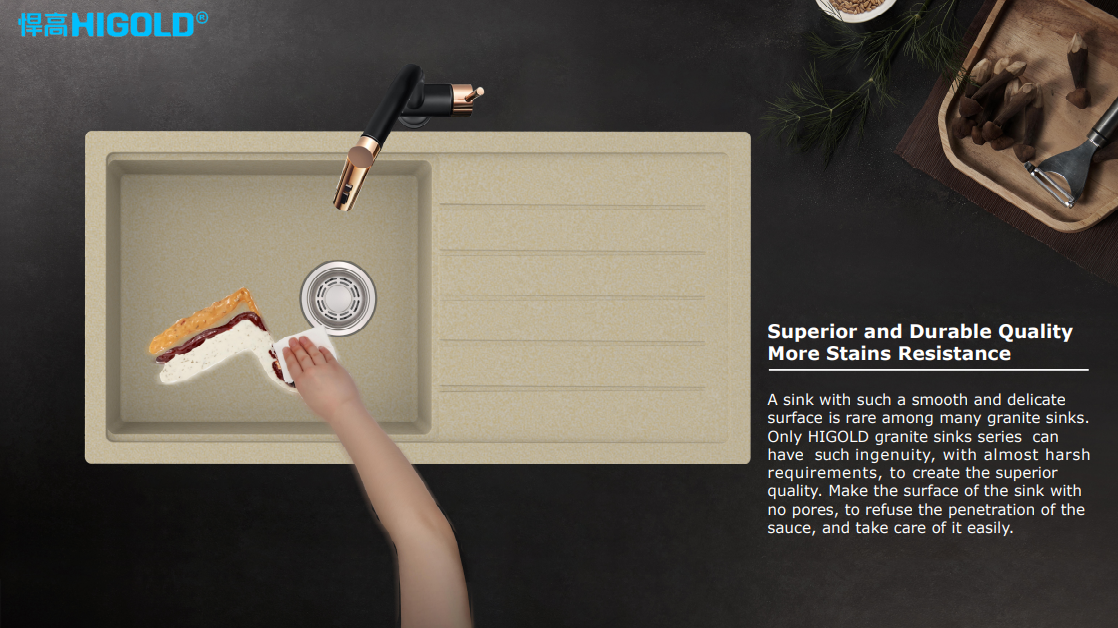Traditional ceramic sinks have long dominated the market due to their elegant, classic appearance and durability. However, in recent years, composite sinks have gradually gained more favor among consumers due to their unique advantages. Composite sinks are composed of synthetic materials such as natural stone powder and resin. Common ones include quartz composite sinks and stainless steel composite sinks. In contrast, ceramic sinks are famous for their high-temperature fired materials, mainly white, and have a classic and modern aesthetic.
So, which is better, the kitchen composite sink or the ceramic sink? This depends on many factors, including durability, cleaning and maintenance, appearance design, and cost-effectiveness. This article will deeply analyze the advantages and disadvantages of composite sinks and ceramic sinks to help consumers make a more appropriate choice.

What is a kitchen composite sink?
Kitchen composite sinks are usually made of natural stone powder (such as quartz sand, granite particles, etc.) and resins, polymers and other materials through high temperature and high pressure synthesis. According to different production processes, the types of kitchen composite sinks are different. Common kitchen composite sinks are quartz composite sinks and stainless steel composite sinks. Quartz composite sinks are highly regarded for their natural stone-like appearance and good wear resistance, stain resistance, and heat resistance. Stainless steel composite sinks are commonly found in some high-end kitchens. Their surfaces are usually specially polished, durable, and easy to clean.
What is a ceramic kitchen sink?
Ceramic sinks are formed by firing ceramic soil or porcelain clay at high temperatures, and their surfaces are hard and smooth. Traditional ceramic sinks are mostly classic white or beige, with simple and elegant shapes. Ceramic sinks have long been widely used in home kitchens because they are fired with natural minerals, have high hardness, smooth surfaces, and are easy to clean.

What are the advantages and disadvantages of kitchen composite sinks?
Advantages of kitchen composite sinks:
Durability and scratch resistance
Kitchen composite sinks are usually made of harder materials than ceramic sinks, especially quartz kitchen composite sinks. The addition of quartz components makes their surfaces hard and can effectively resist common scratches, collisions, wear, and other problems in daily life. In contrast, ceramic sinks are prone to scratches, cracks or gaps after bumps, especially after long-term use, the surface may be damaged.
Excellent anti-fouling performance
The surface of kitchen composite sinks is usually smooth and not easy to adhere to dirt. Quartz kitchen composite sinks are particularly resistant to stains, and oil stains, food residues and scale are difficult to adhere to the surface, making daily cleaning relatively easy. In contrast, although the surface of ceramic sinks is smooth, they are easily affected by oil and water stains. If they are not cleaned for a long time, the surface of the sink may turn yellow and stains are difficult to remove.
High temperature resistance and good heat resistance
Kitchen composite sinks usually have good high temperature resistance, especially in quartz kitchen composite sinks. Quartz itself has strong high temperature resistance and can withstand high temperature objects in daily kitchen environments, such as hot pots, hot water, etc. Although ceramic sinks also have a certain degree of heat resistance, due to the strong brittleness of ceramics, they are prone to cracks due to temperature changes, especially in the case of alternating high and low temperatures, ceramic sinks have a certain risk of rupture.
Rich appearance options
Kitchen composite sinks are available in more colors and styles, and can provide more customized options according to consumer needs. Whether it is black, gray, white, or dark blue, green, etc., kitchen composite sinks can provide more options in color and surface texture, which can be matched with kitchens of various styles to meet the personalized needs of consumers. Ceramic sinks generally maintain classic white or beige. Although they have a certain sense of elegance, they are more monotonous in color matching compared to composite sinks.
Lighter weight
An important advantage of composite sinks over ceramic sinks is their light weight. Ceramic sinks are heavier, especially when installed, they may require additional support. Composite sinks are usually lighter due to their material properties, and are not easy to cause excessive pressure on the cabinet during installation, and are easy to carry.
Disadvantages of composite sinks:
Higher price
Although composite sinks have advantages in durability and aesthetics, they are usually more expensive. The cost of quartz composite sinks is relatively high, especially in imported brands, which may be more than twice as expensive as ceramic sinks. For consumers with limited budgets, ceramic sinks are still a more affordable choice.
Color difference problems may occur
The color and surface texture of composite sinks are made of synthetic materials and processes. Although they can provide a rich selection of colors, individual products may have slight color difference problems due to different production processes, which may affect the uniformity of the overall effect. Ceramic sinks have fewer color difference problems and a more consistent overall appearance due to their classic white or beige tones.
Surface is fragile and prone to cracks
Although the surface of the composite sink is hard, sometimes tiny cracks may occur when it is hit by heavy objects or suddenly contacted by high-temperature objects. Although these cracks will not affect daily use, if they are not repaired in time, they may cause damage to the surface of the sink and affect its appearance. Ceramic sinks are prone to cracks after long-term use due to their fragile materials.

What are the advantages and disadvantages of ceramic sinks?
Advantages of ceramic sinks:
Classic beauty and elegant appearance
The appearance of ceramic sinks is usually simple and elegant, with a strong sense of classics, especially white or beige ceramic sinks, which bring a fresh and bright atmosphere to the kitchen. This makes ceramic sinks the first choice for many families, especially suitable for various kitchen designs such as modern, simple, and country styles.
Strong durability, no deformation after long-term use
The ceramic sink itself has strong durability and corrosion resistance, and will not deform or have quality problems after long-term use. The surface of the ceramic sink is hard, not easily corroded by chemicals such as acids and alkalis, and has a long service life. However, some materials of the composite sink may be affected by long-term friction or chemicals, resulting in aging or surface damage.
Easy to clean and good antibacterial properties
The ceramic sink is relatively easy to clean due to its smooth surface. Its surface is not easy to absorb stains, and oil stains and scale are relatively easy to remove. At the same time, the material of ceramic is not easy to breed bacteria and has good antibacterial properties, so it is more hygienic.
Affordable price and high cost performance
The price of ceramic sinks is relatively low, especially some local brands, which are more affordable and cost-effective. For consumers with limited budgets, ceramic sinks are still an affordable and reliable choice.
Disadvantages of ceramic sinks:
Easy to damage
Ceramic sinks are prone to collision and impact during use, especially when hit by hard objects, cracks or gaps are easy to form. Although ceramic sinks are very hard, their brittleness also makes them vulnerable to external damage, which is a major disadvantage in daily kitchen use.
Uneven heating and easy to crack
Ceramic sinks have poor heating performance and are prone to cracking due to large temperature differences. For example, placing a hot pot directly into the sink or a sudden change in the muddy water in the sink may cause cracks or cracks on the surface of the sink.
Heavy weight and difficult installation
Due to the heavy material of ceramic sinks, more support and reinforcement design may be required during installation. For some kitchens, the heavy weight of ceramic sinks may cause greater pressure on countertops or cabinets.

Comprehensive comparison of composite sinks and ceramic sinks
From durability, stain resistance, appearance design to price, installation convenience and other aspects, composite sinks and ceramic sinks each have their own advantages and limitations. For consumers who pursue high-end, stylish and durable, composite sinks are undoubtedly an option worth considering, especially quartz composite sinks, which perform very well in all aspects. For families with limited budgets and who like classic styles, ceramic sinks are a practical option with high cost performance and simple maintenance. Ultimately, which sink you choose depends on a variety of factors including personal needs, kitchen design style, and budget.
Buy High-Quality Stainless Steel Sinks Directly from the Manufacturer
Looking to buy stainless steel sinks directly from the manufacturer? Higold Group offers premium kitchen sinks and faucets at competitive prices. By purchasing directly from us, you bypass the middleman and get the best value for your money. Our manufacturing facility is equipped with the latest automation technology, ensuring precision and efficiency in every product. Contact us now for wholesale quotes, discounts, and bulk order promotions tailored to your business.


